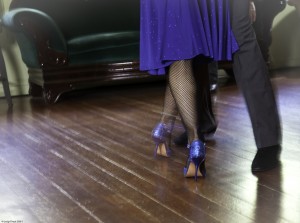 The steps you learn in beginning tango, the ones you need to know in order to have a solid foundation for getting to the improvisational play of tango include:
The steps you learn in beginning tango, the ones you need to know in order to have a solid foundation for getting to the improvisational play of tango include:
• walking – including in normal/parallel and cross systems
• ochos – figure eights, forward and backward
• molinetes – “windmills” or grapevines or giros (turns) to the left and to the right
• 8-count basic to the cruzada or cross (includes the 8-count cross basic, or learning about the two systems of walking – see walking)
Some teachers include voleos in the basic beginner steps, but I feel that they belong in the intermediate category and are not necessary for you to dance tango in a milonga (social venue where tango is danced, also called a “tango party.”)
I would add rock steps or cadencias, including the “cuñita” or “little cradle,” which is a rocking of the two bodies in place. The weight is cradled and rocked over two planted feet, an exception to our much-flaunted “free-leg” principle.
There are always exceptions and contradictions in tango – accept that.
The free-leg principle applies mainly to the beginner who generally always has her/his weight on one leg or the other, as she/he weights for the invitation or lead to step or place her weight.
Now we get into technique, which emanates not only from the way we individually move and share space, but from the way we move and share space and energy together as partners and as couples moving in sync on the dance floor.
For this reason in the beginning classes, we like to do exercises that emphasize:
• How you transfer your weight – presenting or placing the foot that is moving first, then using the floor and gravity to push off from the trailing foot. No bouncing, little hip movement. The motion is forward, backward, or the a side, and is clearly, with intention, carried out.
• Elasticity – this is in conjunction with how you move your body. Despite its simplicity and the elegance of tango, your full body is engaged, just as a rubber band is engaged fully when you stretch it or allow it to recover/snap back. Your foot, leg, torso, arms, work together. This may be the most challenging concept. But it will come with practice. Think of panthers, feline creatures, and the way they move forward. The paw or leg only moves, yet you see the ripples through their muscles. Very sexy and sensual.
• The spiraling or rotation of the upper body in opposition to the lower body (called “contra-body movement, or CBM, in ballroom dance). Ochos, the bread and poetry of tango, require doing this spiraling frequently throughout the dance, no matter what level you are at.
• Stepping with the music – this is something that comes with time as you hear the music and begin to understand and predict the format of tango and its various genres (including pure tango, vals, and milonga rhythms). Tango’s “call-and-response” format will become second nature to you without your having to fully understand it technically. You will begin to hear the strings, bandonenon, the piano keys, the bass. You will hear the beat when it’s there. You will understand and decide when to dance to the melody and when to dance to the rhythm.
I will build upon these steps and principles—with more instruction for leaders and followers. You should know that in Argentina, they do not have labels, “leader” & “follower.” They refer to the man or the woman, both of whom are dancers or tangueros. They refer to la marca, (the lead, we call it) which is the action of the leader who guides or sets the framework.
I leave you with this thought:
The complexity that one attributes to Argentine tango is equal and opposite to one’s ability to remove his/her own obstacle/blocks (whether physical or mental) to dancing tango. Tango is already in us.